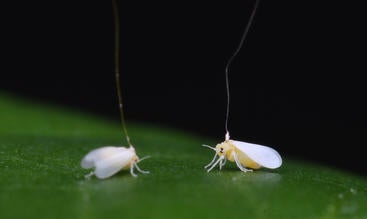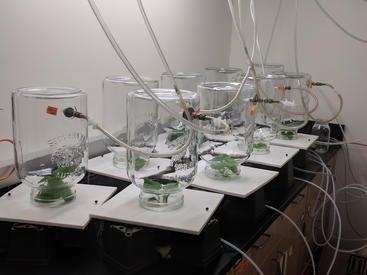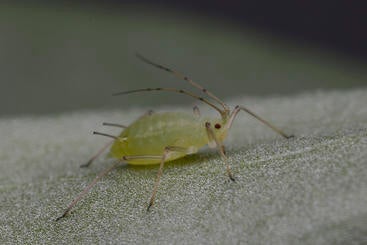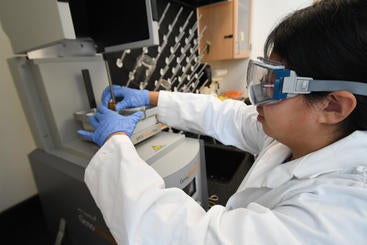Our Research
The Mauck lab conducts basic and applied research on plant-insect-pathogen interactions from organismal to community levels and across ecological transition zones. Presently, we are pursuing three major research goals: the first is to understand mechanisms of plant responses to pathogens and vectors, and to develop strategies for real-time manipulation of plant immunity; the second is to characterize the diversity and impacts of pathogens in wild plant communities; and the third is to elucidate how bacterial symbionts modify the biology, behavior and vector potential of piercing-sucking insects. To tackle these goals, we have established three project areas:
1. Phenotypic responses of plants to pathogens and vectors
Host plant resistance is an efficient means of combating pest and pathogen threats, but poorly understood with regard to connections between traits conferring resistance to insect vectors and the pathogens they transmit. To address this, my laboratory explores the genetic basis and inducibility of virus and vector resistance in wild and cultivated muskmelons, a major crop in California. This work is being performed in collaboration with researchers at USDA-ARS in Salinas, CA, and is supported by a Specialty Crop Block Grant from the California Department of Food and Agriculture. As a component of this work, we are improving phenotyping methods for characterizing host plant resistance and collaborating with computer scientists to automate analysis of complex time-series data produced by phenotyping approaches, including electrical penetration graphing recordings of insect vector mouthparts. These improvements will benefit researchers tackling virus and vector resistance challenges in multiple systems. Presently, with support from USDA-NIFA, we are applying these methods to study inducibility of host plant resistance in other crops, including the citrus greening-citrus psyllid pathosystem that threatens the California citrus industry.
In related work, we are continuing efforts to understand plant virus manipulation of plant phenotypes and vector behavior. There is now substantial evidence that plant viruses can evolve traits to induce specific changes in hosts that enhance transmission-conducive interactions with vectors. However, the implications of this for virus transmission in real-world scenarios are unknown. With support from the California Melon Research Board, we are pursuing work to understand how factors like host plant identity, microbial associations, and chemically-induced immunity priming influence virus effects on vector behavior and performance. By understanding variability in virus-induced changes in host phenotypes, we can hopefully identify means of disrupting these phenotypes in agriculture to reduce virus spread.
2. Pathogens in wild plants: friends or foes?
Due to a historical focus on studying plant pathogen infections in fast-growing annual crops, little is known about the diversity and impact of pathogens on the perennials that structure wild communities. Through our work in the UC Natural Reserve system, we recently found that drought-adapted perennial cucurbits harbor multiple infections by crop-associated and novel viruses. With funding from the Shipley Skinner Endowment we are continuing to develop wild cucurbit species as models for virus and vector ecology while quantifying virus and vector impacts on plant health. In a similar line of work, performed in collaboration with Dr. Allison Hansen, we are pursuing projects to elucidate the diversity and abundance of economically important pathogens in the genus Candidatus Liberibacter. With support from the UCR Center for Infectious Disease Vector Research we are using molecular and bioinformatic approaches to understand disease emergence within the Ca. Liberibacter genus by recovering DNA from historic and contemporary wild plant specimens. Future work in this collaboration will tackle Ca. Liberibacter diversity in psyllids, which are hypothesized to be the ancestral hosts for plant pathogenic Ca. Liberbacter species.
3. Community-based Potato Psyllid Sampling
Another new research direction in the Mauck lab is aimed at gaining a better understanding of the genetic diversity and spatiotemporal distribution of the potato psyllid (Bactericera cockerelli), the primary North American vector of Ca. Liberibacter solanacearum, in natural plant communities vs. agroecosystems. To accomplish this goal, we are calling on volunteers to help us sample potato psyllids from both wild and crop plants throughout the western USA. For more information on how you can contribute to this project, please visit our Community-based Potato Psyllid Sampling page.
4. Symbiont modification of plant-hemipteran interactions
Piercing-sucking vectors feed on plants through secretion of effector proteins that suppress defenses. Characterization of effector proteins will advance technologies for disrupting vector feeding and pathogen transmission. As new effectors are discovered, we are also learning that bacterial symbionts living within vectors can have profound effects on saliva content and activity. Using a whitefly symbiont system developed by our collaborator, Dr. Martha Hunter (University of Arizona), we recently discovered that induction of systemic defenses against whiteflies is influenced by whether or not the insects carry a facultative symbiont. With support from USDA-NIFA we are characterizing the effects of symbionts on whitefly salivary effector composition and function. With support from a UC Multicampus Research Programs and Initiatives program, we are performing parallel work on effectors in psyllid vectors in association with Candidatus Liberibacter symbionts. Effector biology is an exciting and challenging new direction in my lab that will yield a wealth of data for applied and basic research on microbe-host-vector interactions.
Side projects
In the Mauck Lab we are easily distracted by cool side-projects, especially those involving fun people. In addition to the work described above, we are involved with the following projects:
1. Development of in-hive sensors for bee health monitoring. Lead researcher: Boris Baer, UCR Dept. of Entomology
2. VOC emissions by fungistatic bacteria. Lead researcher: Jason Stajich, UCR, Microbiology and Plant Pathology
3. Hormone profiling in bumble bees. Lead researcher: Hollis Woodard, UCR Dept. of Entomology
4. Aphid responses to predator cues. Collaborator: Erin Wilson-Rankin, UCR Dept. of Entomology
5. Molecular identification of native Fulgoroidea and their symbionts. Lead researcher: Mark Hoddle, UCR Dept. of Entomology.
Techniques
The Mauck lab uses a diverse toolbox to make progress on the research projects described above. Our work combines techniques in electrophysiology, chemical ecology, insect behavior, and molecular biology. We work in the lab, on experimental farms, and in wild habitats.




